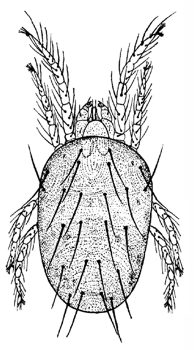Pests
Tetranychus viennensis Zacher - Hawthorn Red Spider Mite, Fruit Tree Spider Mite
Systematic position.
Class Arachnida, order Acariformes, superfamily Tetranychoidea, family Tetranychidae, genus Amphitetranychus Oud.Synonyms.
Amphitetranychus viennensis Zacher; Tetranychus crataegi Hirst; Apotetranychus virginis Ugarov; Apotetranychus longipenis Ugarov et Nikol'sky.Biological group.
Pest of apple, pears, peach, sloe, cherry, plums, cherry plum.Morphology and biology.
Life cycle of mites includes egg, larvae, protonymph, deutonymph, and adult. Body of female oviform; length is 0.55 mm, width is 0.3 mm. Female is light-green after emergence, reddens in 2-3 days; only legs and gnatosoma are light-colored. Propodosoma is without frontal prominences above gnatosoma. It has a piercing and sucking type of mouthpart. 24 setae in 6 transversal rows are located on dorsal side of body. Female lives about 23-30 days; average fertility is 70-85, maximum 156 eggs. Mating occurs immediately after emergence. Male body narrower, narrowed posteriad, light green with black spots on each side. Eyes are bright red. Body length is 0.4 mm; body width is 0.19 mm. 26 setae in 6 transversal rows are located on dorsal side of body. It has a Arrhenotoky type of parthenogenesis. Eggs are globular, with smooth surface, transparent, then greenish-pink. Egg is suspended on a web thread; its diameter is 0.15 mm. Body of larvae rounded and convex, transparent-green, with red eyes, black spots on each side of body, and with 3 pairs of legs. Protonymph and deutonymph are elongated oval, with 4 pairs of legs; dorsal chaetotaxy the same as on adult. Female develops from egg to adult in 12-38 days, male in 1-2 days less time. The species produces 7-9 generations in Crimea.Distribution.
The species is widely distributed in England, France, Germany, Austria, Bulgaria, Northern India, Korea, China and Japan. In the former USSR it inhabits Moldavia, Ukraine, Central Chernozem Region and Primorskii Territory of Russia, the Caucasus, Southern Kazakhstan, Uzbekistan and Tajikistan.Ecology.
The major host plants for this species belong to the Rosaceae family; the pest occurs on walnut too. Only fertilized females hibernate (up to 50 specimens together) under exfoliating bark on trunks, rarely among the fallen leaves, or in the surface layer of soil. Mortality of females during hibernation is about 50%. Spring activity, after diapause, starts with an average air temperature of 10°C or more and continues until the blossoming of pear or the blossoming of apple buds. Females migrate to the underside of leaves, pierce epidermis of leaf by chelicerae, and suck cell plasma. Injured leaf turns yellow; its underside is colonized with a colony of mites and covered with web. The number of males in populations is 3-5 times less than that of females. Temperature threshold of development is about 10°C. The total degree days required for one generation to develop is 185°C. Population density in nature depends on the activity of predators, e.g., Orius albidipennis Reut, Scolothrips acariphagus Sarh., Chrysopa spp., Typhlodromus reticulatus Oud.Economic significance.
Excessive use of pesticides in the middle of the 20th century in the former USSR stimulated outbreaks of A. viennensis. These were mainly connected to the elimination of entomophages in gardens and to the capability of mites to develop resistance against pesticides. Trunks and branches of fruiters were densely covered by webs after mass propagation of mites. Strongly infested trees are defoliated and bud formation is decreased the next year. Yield of plum is reduced 2-3 times. Cultivation of resistant varieties of fruit and whitewashing of tree trunks are now important preventive control measures against A. viennensis. Control measures also include acaricide treatment in spring after mass appearance of the mites with an average air temperature of 10°C. A. viennensis may be a vector of Apple Scab and Mildew of Apple.Reference citations:
Bagdasaryan A.T. 1957. Fauna of the Armenian SSR. Tetranychid mites (Superfamily Tetranychoidea). Yerevan: AN Armenian SSR. 163 p. (In Russian)Batiashvili I.D. 1965. Pests of continental and subtropical fruit crops. Tbilisi: Ganatleba. 336 p. (In Russian)
Livshits I.Z. 1960. Brown fruit mite (Bryobia redikorzevi Reck, 1947). Systematics, morphology and biology. Pests and diseases of fruiters and decorative plants. Proceedings of the Nikitsky Bot. garden (Yalta), 33: 3-76. (In Russian)
Livshits I.Z., Mitrofanov V.I. 1973. A contribution to the fauna and biology of tetranychid mites of the Crimea (Acariformes, Tetranychoidea). Proceedings of the 3rd international congress of the Acarology. Prague: Academia. 229-235 p. (In English)
Livshits I.Z., Mitrofanov V.I. 1984. Order Acariformes. In: Kopaneva L.M., ed. Keys to harmful and useful insects and mites on the fruiters and berry crops in the USSR. Leningrad: Kolos. 288 p. (In Russian)
Mitrofanov V.I., Strunkova Z.I., Livshits I.Z. 1987. Keys to the tetranychid mites (Tetranychidae, Bryobiidae) fauna of the USSR and adjacent countries. Dushanbe: Donish. 224 p. (In Russian)
Reck G.F. 1959. Keys to tetranychid mites. Tbilisi: AN Georgian SSR. 151 p. (In Russian)
Reck G.F. 1976. Catalogue of Acariformes of the Georgian SSR. Tbilisi: Metsniereba. 128 p. (In Russian)
Savkovskii P.P. 1976. Atlas of pests of fruit and berry plants. Kiev: Urozhai. 207 p. (In Russian)
Strunkova Z.I. 1967. About biology of Tetranychus viennensis Zacher in Tadjikistan. Izvestiya AN Tadzhikskoi SSR (Dushanbe), 3(28): 47-58. (In Russian)
Vasil'ev V.P., ed. 1973. Pests of agricultural crops and forest plantations. V. 1. Kiev: Urozhai. 496 p. (In Russian)


